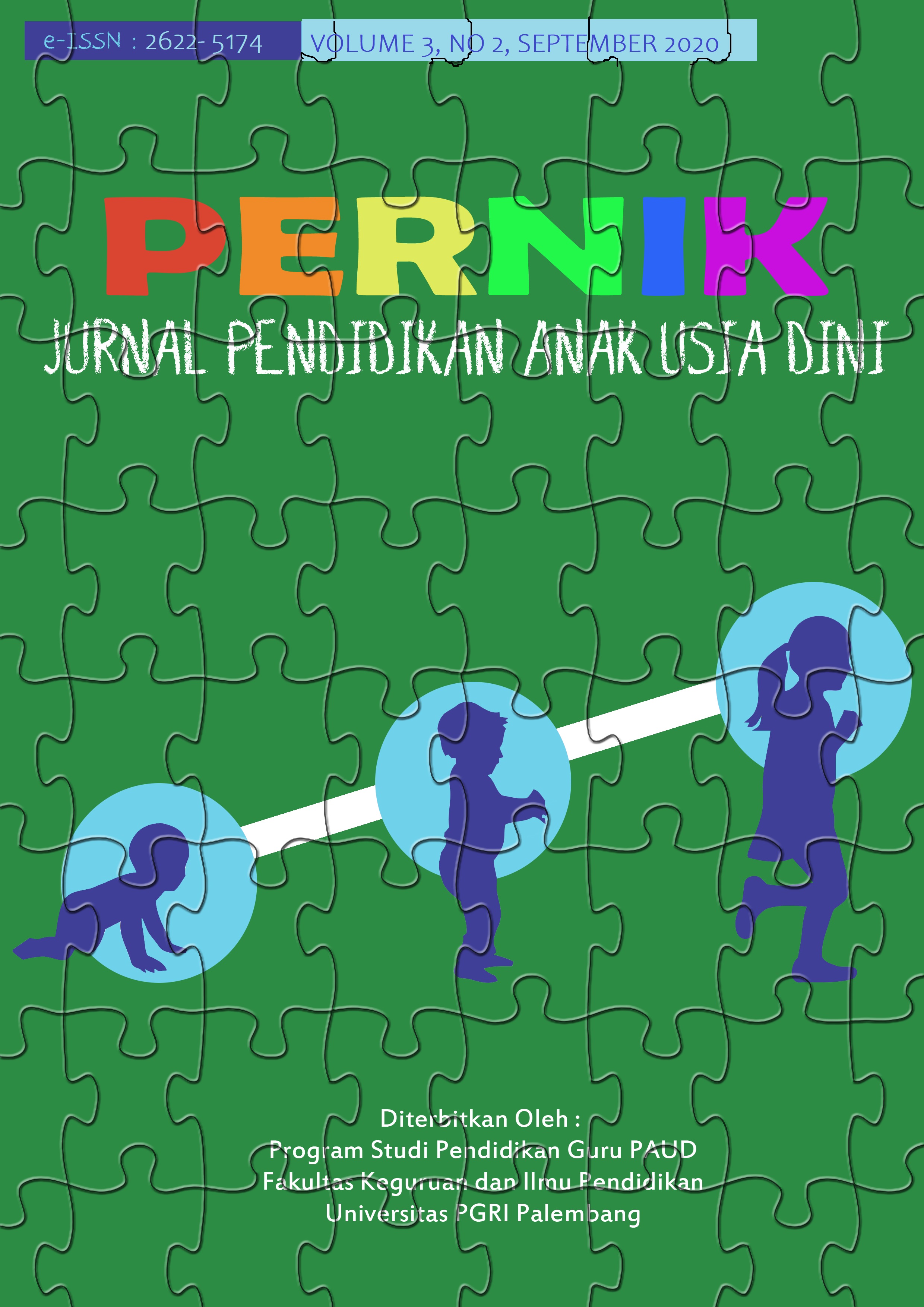Bagaimana Konstruksi Gender dalam Permainan Outdoor di PAUD?
DOI:
https://doi.org/10.31851/pernik.v3i2.4810Keywords:
Children, Gender issues, Outdoor, PlayAbstract
Abstract— Playing is an inseparable part of the child's world. This article focuses on outdoor play as the first physical game. What I mean by outdoor play in this article includes playing football, jumping rope, and other outdoor games. There is a widely held assumption that gender is an analytical factor in children's play. The myth is that boys have a higher interest in outdoor play than girls. Includes mastering the place to play. Thus, analyzing the discourse of outdoor play in early childhood education from a gender perspective will contribute to understanding game development in early childhood education. Through a case study research at a kindergarten in Palembang Indonesia, this article finds power relations in children's outdoor games in kindergarten and examines how teachers, parents and other adults address the gender gap in outdoor games.
Keywords— Children, Gender issues, Outdoor, Play
Abstrak— Bermain menjadi sebuah bagian yang tidak terpisahkan dari dunia anak. Artikel ini berfokus pada permainan outdoor sebagai permainan fisik pertama. Yang saya maksud dengan permainan outdoor di artikel ini termasuk bermain sepak bola, lompat tali, dan permainan outdoor lainnya Ada anggapan yang diyakini secara luas bahwa gender merupakan salah satu faktor analitis dalam permainan anak. Mitosnya adalah anak laki-laki memiliki minat bermain outdoor yang lebih tinggi daripada anak perempuan. Termasuk didalamnya pada penguasaan tempat bermain. Dengan demikian, menganalisis diskursus permainan outdoor dalam pendidikan anak usia dini dari perspektif gender akan berkontribusi pada pemahaman pengembangan permainan dalam pendidikan anak usia dini. Melalui penelitian studi etnografi di sebuah taman kanak-kanak di Palembang Indonesia, artikel ini menemukan adanya relasi kuasa dalam permainan outdoor anak di TK dan meneliti bagaimana guru, orang tua dan orang dewasa lainnya mengatasi kesenjangan gender dalam permainan outdoor.
Kata Kunci— Anak, Isu Gender, Outdoor, Permainan
References
Adriany, V. (2019a). Being a princess: young children’s negotiation of femininities in a Kindergarten classroom in Indonesia. Gender and Education, 31(6), 724–741. https://doi.org/10.1080/09540253.2018.1496229
Adriany, V. (2019b). ‘I don’t want to play with the Barbie boy’: Understanding Gender-Based Bullying in a Kindergarten in Indonesia. International Journal of Bullying Prevention, 1(4), 246–254. https://doi.org/10.1007/s42380-019-00046-2
Adriany, V., & Warin, J. (2014). Preschool teachers’ approaches to care and gender differences within a child-centred pedagogy: findings from an Indonesian kindergarten. International Journal of Early Years Education, 22(3), 315–328. https://doi.org/10.1080/09669760.2014.951601
Azlina, W., & S., Z. A. (2012). A Pilot Study: The Impact of Outdoor Play Spaces on Kindergarten Children. Procedia - Social and Behavioral Sciences. https://doi.org/10.1016/j.sbspro.2012.03.349
Bjørgen, K. (2016). Physical activity in light of affordances in outdoor environments: qualitative observation studies of 3–5 years olds in kindergarten. SpringerPlus. https://doi.org/10.1186/s40064-016-2565-y
Dealey, R. P., & Stone, M. H. (2018). Exploring Out-of-School Play and Educational Readiness. Early Childhood Education Journal, 46(2), 201–208. https://doi.org/10.1007/s10643-017-0849-7
Dinella, L. M., & Weisgram, E. S. (2018). Gender-Typing of Children ’ s Toys : Causes , Consequences , and Correlates Why Are There Gender Differences in Toy. Sex Roles, 79(5–6), 253–259.
DiPrete, T. A., & Jennings, J. L. (2012). Social and behavioral skills and the gender gap in early educational achievement. Social Science Research. https://doi.org/10.1016/j.ssresearch.2011.09.001
Fakih, M. (2013). Analisis Gender dan Transformasi Sosial. Yogyakarta: Pustaka Pelajar
Keddie, A. (2003). Little Boys: Tomorrow’s macho lads. Discourse. https://doi.org/10.1080/0159630032000172498
Kementerian Pemberdayaan Perempuan dan Perlindungan Anak. (2018). Pembangunan manusia berbasis gender. In Kementerian Pemberdayaan Perempuan dan Perlindungan Anak (Vol. 95).
Kollmayer, M., Schober, B., & Spiel, C. (2018). Gender stereotypes in education: Development, consequences, and interventions. European Journal of Developmental Psychology, 15(4). https://doi.org/10.1080/17405629.2016.1193483
Lynch, M. (2015). Guys and dolls: a qualitative study of teachers’ views of gendered play in kindergarten. Early Child Development and Care, 185(5), 679–693. https://doi.org/10.1080/03004430.2014.950260
Lestari, M., & Yulindrasari, H (2020, August). Gender and Reading Literacy in Early Childhood Education. In International conference on Early Childhood Education and Parenting 2019 (ECEP 2019) (pp. 174-176) Atlantis Press.
MacNaughton, G. (2000). Rethinking Gender in Early Childhood Education. New South Wales: Allen & Uwin
Mac Naughton, G. (2005). Doing Foucault in Early Childhood Studies Contesting Early Childhood Series Series Editors: Gunilla Dahlberg and Peter Moss.
Downloads
Published
Issue
Section
License
Authors retain copyright and grant the journal right of first publication with the work simultaneously licensed under a Creative Commons Attribution-NonCommercial-ShareAlike 4.0 International License. that allows others to share the work with an acknowledgement of the work's authorship and initial publication in this journal.





